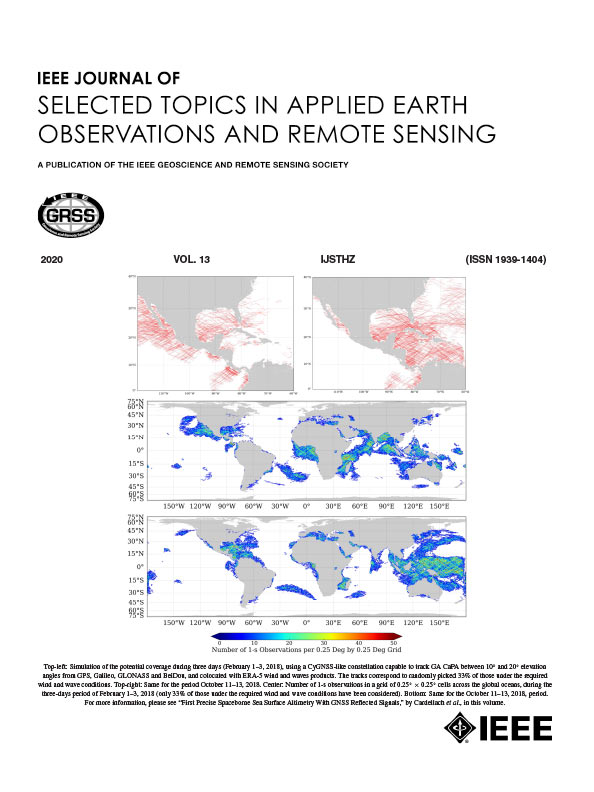基于频域旋转增强和多分支对抗路由的高光谱开集分类
IF 5.3
2区 地球科学
Q1 ENGINEERING, ELECTRICAL & ELECTRONIC
IEEE Journal of Selected Topics in Applied Earth Observations and Remote Sensing
Pub Date : 2025-09-23
DOI:10.1109/JSTARS.2025.3613445
引用次数: 0
摘要
高光谱图像已成为先进材料表征和环境监测中不可或缺的一部分,然而传统的分析框架仍在努力应对开放世界场景中光谱特征不断变化的本质。开放集分类通过在推理过程中识别已知和新的光谱类别来解决这一基本限制。关键的技术障碍包括多角度采集的旋转不变性、跨光谱分辨率的多尺度特征兼容性、频域判别衰减以及形态相似化合物的干扰。为了克服这些挑战,我们提出了一种频域多分支对抗性路由开放集网络,集成了四个核心创新:分数阶傅里叶变换层用于旋转等变光谱定位,多分支动态门路由用于不确定性量化分层特征融合,双频增强模块通过学习频率门分离诊断频谱成分,以及多尺度自适应动态对抗频谱机制,实现联合频谱空间注意细化。自适应谱算子和不确定性感知结构的数学协同设计为动态谱环境下的鲁棒开集分析奠定了新的理论基础。本文章由计算机程序翻译,如有差异,请以英文原文为准。
Hyperspectral Open-Set Classification via Frequency-Domain Rotation Enhancement and Multibranch Adversarial Routing
Hyperspectral images have become indispensable for advanced material characterization and environmental monitoring, yet conventional analytical frameworks struggle with the evolving nature of spectral signatures in open-world scenarios. Open-set classification addresses this fundamental limitation by enabling recognition of both known and novel spectral categories during inference. Key technical barriers include rotational invariance in multiangle acquisitions, multiscale feature compatibility across spectral resolutions, frequency-domain discriminative decay, and interference from morphologically similar compounds. To overcome these challenges, we propose a frequency-domain multibranch adversarial routing open-set network integrating four core innovations: fractional Fourier transform layers for rotation-equivariant spectral localization, multibranch dynamic gate routing for uncertainty quantified hierarchical feature fusion, dual-frequency enhancement modules separating diagnostic spectral components through learned frequency gates, and a multiscale adaptive dynamic adversarial spectral mechanism enabling joint spectral–spatial attention refinement. The mathematical codesign of adaptive spectral operators and uncertainty-aware architectures establishes new theoretical foundations for robust open-set analysis in dynamic spectral environments.
求助全文
通过发布文献求助,成功后即可免费获取论文全文。
去求助
来源期刊
CiteScore
9.30
自引率
10.90%
发文量
563
审稿时长
4.7 months
期刊介绍:
The IEEE Journal of Selected Topics in Applied Earth Observations and Remote Sensing addresses the growing field of applications in Earth observations and remote sensing, and also provides a venue for the rapidly expanding special issues that are being sponsored by the IEEE Geosciences and Remote Sensing Society. The journal draws upon the experience of the highly successful “IEEE Transactions on Geoscience and Remote Sensing” and provide a complementary medium for the wide range of topics in applied earth observations. The ‘Applications’ areas encompasses the societal benefit areas of the Global Earth Observations Systems of Systems (GEOSS) program. Through deliberations over two years, ministers from 50 countries agreed to identify nine areas where Earth observation could positively impact the quality of life and health of their respective countries. Some of these are areas not traditionally addressed in the IEEE context. These include biodiversity, health and climate. Yet it is the skill sets of IEEE members, in areas such as observations, communications, computers, signal processing, standards and ocean engineering, that form the technical underpinnings of GEOSS. Thus, the Journal attracts a broad range of interests that serves both present members in new ways and expands the IEEE visibility into new areas.

 求助内容:
求助内容: 应助结果提醒方式:
应助结果提醒方式:


